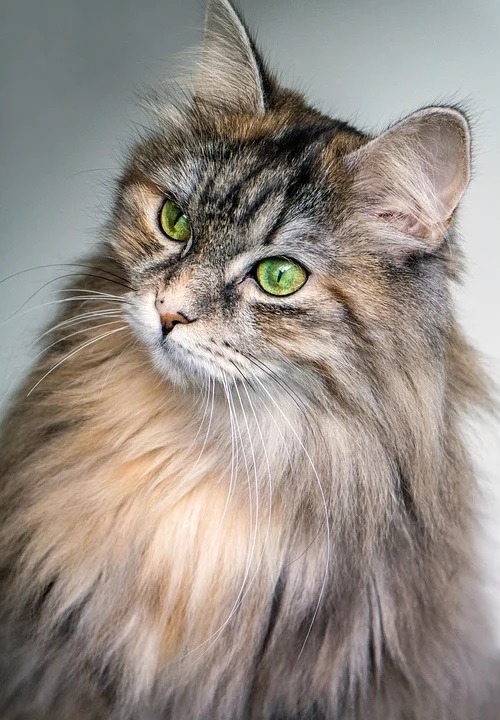It is no secret that if you are a cat person, you do not have a hard time loving one or more cats. However, it is hard for you to choose just one. To some people, animals provide them so much joy!
However, you might worry about keeping them and not being able to take care. We must do everything to keep our pets happy and healthy. Want to check if your little animal is living a healthy life? Then check its appearance, especially fur. Healthy skin is gentle and clear of infections and other abnormalities.
Causes Of Poor Fur
The dullness of a coat or the dryness and flakiness of its skin might be of many factors. The following are some of the most common reasons:
Poor Nutrition
Animals like humans require a balanced diet of carbs, proteins, and fats for healthy hair, skin, and body. And, just like you, if your cat only consumes low-quality, difficult-to-digest food, it will suffer. Kitty could be deficient in essential minerals and vitamins.
Weight Problems
When cats gain weight, they lose the ability to clean their entire bodies. According to the stats, 57 percent of cats in the United States are overweight or obese. It can result in a dingy, untidy coat.
Bathing too Often
If you bathe your pet too frequently, you may be the cause of the cats’ unkempt coats. Some people wash their cats to reduce dander or repel fleas.
Age
Cats can become arthritic or less flexible as they age. As a result, your generally picky feline’s coat may become dull and rough due to age or suffering.
Tips on How to Keep Fur Healthy
While cats are fastidious animals that do their best to keep their surroundings clean. They occasionally require assistance for this. Brushing, bathing, and inspecting your cat for fleas will reduce hairballs and maintain the skin healthy, as well as its coat full, lustrous, and tangle-free.
Brushing the Cat
Check the coat regularly:
The natural sheen and spring is a good indicator of general health. Dirt, oils, and other contaminants, on the other hand, can wreak havoc on its appearance.
Once or twice a week, give your cat a once-over. There should be no bald patches, lumps, sores, or flea infestation indications.
Stay updated out for any indicators of a ruined coat. Dryness, greasiness, dandruff, thinning hair, or a lackluster appearance are examples.
Because their coats tend to mat, long-haired cats require extra care. When inspecting them, look for tangles.
Make Grooming a Good Experience.
Your cat needs to get handled on occasion, make sure he is used to it and appreciates it. Begin slowly, be patient, and make sure the experience is enjoyable.
For good results, groom your cat in a good mood and calm, such as after exercise or feeding.
Make sure you are comfortable as well! If you groom your cat when you are agitated, he will link grooming with violence or fear.
If you are starting, keep your sessions to 10 to 15 minutes until you have established a habit. Pet your cat all over so it becomes used to the attention – the head, ears, tail, feet, and tummy are all places to start.
Patience is required. If it is difficult, try again later and reward the cat with a treat after each successful session.
Brush a Short-haired Cat Once Per Week
Cat varieties like Bengals, Americans, and Abyssinians have short hair. Short-hair cats do not require your full attention. Coving their fur once or less in a week is enough.
To begin, comb its fur from head to tail with a metal comb. Dirt and other debris can get collected as a result.
Brush its short-haired fur along. To put it another way, go with the fur’s grain rather than against it. Brush the entire body, concentrating on one area at a time to release tangles.
Cat bellies and chests are very sensitive. When brushing there, be gentle.
Next, remove any loose or dead hair using a bristle or rubber brush.
Brush The Long-haired Cats More Often.
Persians and Himalayan are long hair breeds like Balinese and need to get brushed more often than short hair cats. As they have long fur, they get more furballs.
Brushing long-haired breeds every day or every other day will loosen knots and remove dead hair. Your cat will generate fewer fur balls if you get rid of hair.
Brush the tummy and legs first. Tangles are more likely to form in certain regions, so be sure to untangle any knots that form.
Brush the entire body against the lay of the fur with a bristle or rubber brush. When you get finished, pull the hair upwards toward its head and then back down.
Make a part along the middle and brush the fur out on either side to produce the tail.
To release tangles, sift some talcum powder over them and try to loosen them with your hands. Consider using a mat-splitter instead. A skilled groomer or your veterinarian should remove severe matting.
Feels and Look for Irregularities
Rub your fingers along its body before each brushing process to feel for anything that is not there. It is essential for both appearance and health.
Feel for knots that are not visible, as well as bumps or symptoms of ticks or fleas. Blood specks might be a dead giveaway.
Lift the tail and examine its backside. Use scissors to cut away any fur matted with feces.
Near the anus, look for tan, rice-sized particles in particular. These are tapeworm segments, and they suggest that your pet got infected with tapeworms.
Bath Your Cat
Avoid Over-Bathing
Cats are self-cleaning and generally capable of taking care of themselves. If your cat has gotten into something filthy or stinky, you may need to bathe her, but you should try to keep her baths to a minimum.
Bathing your cat might cause its skin to become dry. Bathing regularly can alter the oil gland levels, worsening the coat’s condition.
When you wash your cat, use a gentle, cat-friendly shampoo.
Get to Know The Nature of Your Cat.
Cats are well-known for their dislike of water. As with brushing, choose a time when your cat is in a calm, relaxed state. After some play or a brush-down.
If it refuses to bathe, some groomers recommend removing her claws before showering her. It will save you time and stress.
Place a rubber mat or massage in the sink. Your pet will be able to keep her balance and avoid slipping as a result of this.
Choose The Right Plastic Tub or Basin.
You can bathe your cat in a plastic tub or a sink, depending on his size. In the basin, there should be 2 to 3 inches of water. Then gently and carefully place your pet in the tub.
Check to see if the water is too hot. It should be lukewarm to the touch and not too hot.
Make sure the basin is not overflowing with water. In the water, the cat should be standing.
Coat the Cat with Lather
Begin to soak the animal from head to toe. If your sink has a spray hose, you can utilize it. Otherwise, you may use a spray bottle or a pitcher to squirt water.
Put enough shampoo into its coat and start to stir up a lather. Rub the shampoo through its fur from head to tail, being careful not to get it in her eyes or on her face.
Mix one part cat shampoo with five parts water to make a solution.
Many cats dislike getting sprayed in the face with water. Use a moist washcloth to clean your pet’s head to avoid a tense situation.
Wash and Dry
It is time to rinse when you have worked up a good lather. Using a spray nozzle or a pitcher, rinse out the shampoo with simple, lukewarm water.
Confirm that you got rid of all the shampoos out of the bottle because excess shampoo can irritate the skin and attract dirt.
To dry, wrap it in a thick towel and place her in a draft-free area.
Long-haired cats should get brushed or combed after bathing.
After a bath, offer your cat a treat to reinforce the experience. Reduce her tension and terror to the greatest extent possible.
Get Rid Of fleas
Keep an eye
Any evidence of movement on your cat’s fur, as well as any changes in behavior, like frequent scratching, should be noted. These and other factors may indicate that it has fleas.
Flea bites itch a lot. In an attempt to get rid of fleas, a flea-infested cat may scratch or bite at its coat vigorously.
Your cat may also groom excessively, lose hair, be anxious or restless, or have red sores or pimples (bites marks).
Fleas also leave feces in your cat’s coat, which looks like black pepper.
Own a Fine Brush For the Cat.
Slowly pick your way through the coat with a metal-toothed comb. Fleas will get weeded out, and the irritation will be relieved to some extent.
Many fleas and their eggs get removed with the combing treatment. To get rid of them, dip the comb into a dish of soapy water as you go.
Repeat the therapy every several days until the animal is free of the infestation.
Baths and Wash the fleas Away
Washing your cat and flushing the fleas out of the coat is another alternative. Proceed as if you were giving the animal a regular bath, but use a flea-killing shampoo.
Place the cat in a bowl filled with a few inches of cool, calming water.
Apply a shampoo, preferably one with ingredients like cedar, eucalyptus, lavender, or citrus that are known to repel fleas.
Certain people think it is a good idea to use apple cider vinegar to get rid of fleas.
If you still see fleas and infestations, look for spot treatments!
Bottom Line
The coat of the cat is its crowning splendor, and it can also reveal a lot about his overall health. The article makes sure to provide you enough information to take care of your pet!
We also recommend checking out 10 weird cat habits!

